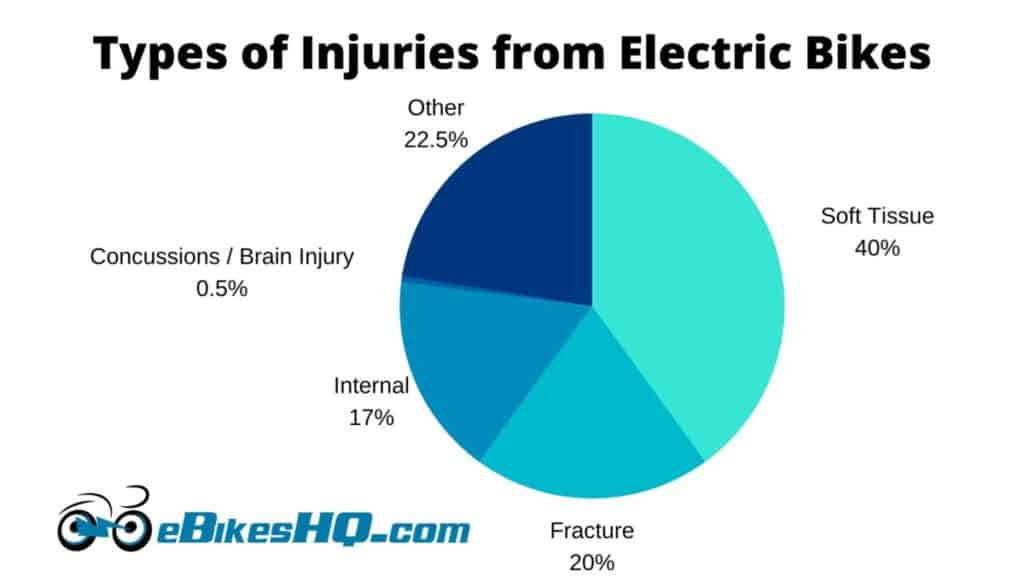Electric bikes are growing in popularity and are starting to shape the way we travel and most of us couldn’t be more excited about it. Only a few years ago it was uncommon to see ebikes roaming the streets, but it’s now becoming commonplace to see these modes of transportation running silently in many cities today. With this popularity also comes more scrutiny about the dangers of electric bikes.
In this article, we look into if and when electric bikes may become dangerous, what risks do they pose and what ideas can be developed to reduce the possibility of hazard and improve safety.
So Are Ebikes Dangerous?
There are definitely risks associated with any activity that involves speed, traffic, pedestrians, and varying road and trail conditions and electric bikes are no exception. In this sense, riding and being around electric bikes, is comparable to the dangers of regular bikes. A recent white paper found “there is no definitive answer regarding whether e-bikes are more or less safe than conventional bicycling, and under which circumstances.” That said, ebikes do pose some dangers and risks – to those riding them and to those around them.
So What Are The Dangers to Electric Bikes?
There are a few dangers unique to electric bikes and a few that are similar to traditional pedal bikes including:
- Dangers to Pedestrians
- Dangers due to increased Speed
- Dangers with the batteries
- Dangers with operating an ebike
Dangers To Pedestrians
Bikes aren’t particularly noisy means of transportation. Absent from any combustion engine, an unaware pedestrian may find that they only hear an electric bike coming after it’s missed them by a couple of inches.
Electric bikes can take this scenario up a notch, giving them increased speed and performance whilst maintaining low noise levels – after all, you won’t be hearing the rider struggle to get his bike uphill a mile away and some ebike motors can be very quiet.
This particular subject has been debated with regards to all types of electric vehicles and many solutions have been debated over recent times. The absence of any noise poses a danger for pedestrians that remain unaware of their presence until it’s too late.
That has led many legislators and manufacturers to approve the need to include some type of noise to make pedestrians and animals aware of the incoming threat. Be as it may, laws in many places currently don’t mandate the use of bells or other noise warning devices.
For example, the Times in the UK reports:
“Existing laws require bikes to be fitted with a bell when they are sold as new but there is no legal requirement to keep them on bicycles or use them on the road. … The Highway Code merely suggests that cyclists “should be considerate of other road users, particularly blind and partially sighted pedestrians”.
And local and state laws for bells on bikes can be all over the map.
With regulations in this area varying so much, this particular threat remains real.
Quoting a recent study, “Regulations should be tailored to assure e-bike vehicle design, infrastructure design, and operations maintain safety of all road users while promoting innovation.”
Until it happens, the best option for pedestrians is to remain ever vigilant should a rocket-fast electric bike come your way, and for riders of electric bikes to be cautious around pedestrians and have a bell or other noise signaling device.
Electric Bikes and Speed
Electric bikes tend to be fast, or at least faster than your typical pedaling efforts. But surprisingly many studies show that average speed between conventional bikes and Class 1 Ebikes are not as different as I would have thought.
On average Class 1 Electric bikes are about 3 km/hr (1.9 mph) faster than traditional bikes – this is generally in an urban environment. Class 3 electric bikes were found to be about twice as fast, on average, as traditional non-powered bikes.
Class 1,2, & 3 Ebikes…
- Class 1 (US): Pedal assist only, maximum assisted speed 20 mph (32 km/hr)
- Class 1 (Europe): Pedal assist only, maximum assisted speed 15 mph (25 km/hr)
- Class 2: Throttle controlled, maximum assisted speed 20 mph (32 km/hr)
- Class 3: Pedal assist only, maximum assisted speed 28 mph (45 km/hr)
The graph below shows the ranges of average speeds for regular bikes, Class 1 ebikes, and Class 3 ebikes. This information was gathered from a number of studies within this white paper.


As this data shows, electric bikes don’t come with a ludicrous mode that will sky-rocket you through the city streets, they do perform faster in comparison to bicycles.
A recent white paper, synthesizing a number of studies on electric bikes and their safety identifies a direct correlation between electric bikes higher speeds and the increased risk of crashes by stating that “(…)errors and conflicts are compounded by speed (as shown in naturalistic studies), Class 3 e-bikes could generate higher speed-related crash risk.”
That poses risks for both riders and pedestrians and may often surprise you.
As speeds and acceleration increase substantially, so does the risk for severe injury, which has seen a “large increase in injuries of e-bike riders over the past decade”, according to the same white paper above.
Lastly, acceleration can be tricky to handle when you’re first starting. Unlike other vehicles, electric ones can deliver full power and acceleration once you’ve hit the throttle or enganged the motor.
It can be daunting to start with and it will take some getting used to. In that learning stage, you’re more prone to mistakes so make sure you start in a low power / low assistance mode and work your way up to higher levels of power as you get going.
Injuries – What are the Chances and What Types are Common?
What are the chances of getting injured? Much of that can depend on the type of riding you do. Commuting in busy traffic, mountain biking, cruising the boulevard all come with varying levels of risk. However, this study estimates risks based on US studies as:
The resultant approximate annual injury rate is 1.4 injuries per
1,000 e-bikes.

Similar to traditional bikes, there are a number of types of injuries that occur with riding an electric bike. These include soft-tissue injuries (40%), fractures (20%), internal injuries (17%), and concussion or traumatic brain injury (0.5). I’m not sure what the other 22.5% included, but I can only assume it involved injuries more minor than those above.
Are There Dangers With the Battery?
Just as with any piece of technology, your electric bike may just give up on you and leave you stranded when you most need it – usually on a rainy day when you’re halfway through an uphill.
Though the mechanics of electric vehicles are rather simple – still things don’t get much simpler than a regular bike – the actual systems that make your electric bike function may be affected by weather, age or the general quality of the components (especially the battery).
In worse case scenarios, these can include a lithium battery fire.
Though that may seem like a very unlikely scenario (and it is), there have been occasions where batteries have erupted in flames, both while people were riding them or during the charging process.
Lithium battery fires are scary events, especially with such a lot of energy packed into a high capacity ebike battery, part of the reason it’s difficult to take an electric bike on a plane. This could make some people think twice about getting an electric bike but they are extremely rare and often they result from people not following basic safety rules or manufacturer recommendations.
If and when owners of electric bikes take the necessary precautions in following official recommendations and buying manufacturer-approved replacements, odds are that such events should rarely occur.
Sure, that official battery pack will cost four times more than the least expensive alternative coming from overseas, but it can just be the difference between getting to your destination safely or watching your precious bike become a fireworks show!
Modern designs include battery management systems (BMS) for practically all lithium-ion batteries packs for ebikes. These are small circuit boards that are in place to increase safety, preventing them to overheating or being negatively affected by high temperatures and overcharge.
Are Basic Traffic Rules Being Observed?
It’s often said that the main problem with driving a vehicle is often found between the seat and the wheel. That same principle is also true when it comes to electric bikes. Riders can often be oblivious when it comes to basic traffic rules and will put themselves and others in harm’s way without giving it a second thought.
Whilst motorcycle drivers are tested and have to pass exams, most laws still don’t see electric bikes as a means of transportation that could benefit from such knowledge or testing.
Basic traffic signs such as stop signs, red lights and priorities are often ignored by people involved in these events with quite serious risks. Some studies have found that red-light running was nearly identical for conventional bicycle and Class 1 & Class 3 e-bikes.
Will Mass Adoption of Ebikes be an Issue?
As much as we have covered some specific dangers to the individual use of an electric bike, mass adoption will most likely result in multiplying these issues.
As it stands, electric bikes are still a minority and though their adoption is rising fast, outside big developed cities, they are still a rare sight.
The more people that start getting to know about the great features and advantages of owning such simple yet effective means of transportation, the tendencies that are now observed in small numbers will surely be in rising numbers in the next few years.
Statistics show that the number of accidents involving electric bikes is rising and they are mostly due to the average speed being higher in electric bikes than they are in traditional ones.
As the number of ebike users increases, especially in the older age bracket, we can predict that the number of injuries and incidents will keep rising alongside the adoption of this technology.
Ultimately, it is up to riders to take in due consideration basic safety measures as well as adopt defensive and responsible attitudes when they’re out in the street, not only as a means of self-protection but also to ensure that no harm is done to others.
Just as with any other great device and particularly with regards to means of transportation, its responsible use is the key factor when it comes to ensuring these statistics can be kept in check.
How Can Dangers be Avoided/Reduced?
Improving Safety on Electric Bikes
Improving safety of electric bikes can start with you. Most of the dangers that occur from its use are human-factor related.
They often result in adopting the wrong attitude when it comes to safety, either by not observing basic traffic rules or simply by using and abusing the immediate power and higher speed of the electric bike without adjusting to experience levels or the specifics of the location where you’re riding.
For riders it comes down to a few commonsense points:
- Wear a helmet! Wearing a helmet is still not a law in many countries and US states, which I find surprising! Protecting your head in any activity that could seriously injure you is a no-brainer! (was that a cringe-worthy pun or what?)
- Ride within your ability and to the conditions of the road. Another commonsense tactic is to ride to the conditions of the road. If it’s dark, make sure you have hi-vis gear and lights. If it’s wet, slow down and take care when braking and turning. If it’s cold and the roads and bike paths are covered in black ice….well you probably shouldn’t be out in that type of weather in an ebike anyway.
- Maintain and care for you ebike properly. Regular tune-ups, replace worn tires and brakes, keep lights and other components in working order.
- Proper Care and Replace batteries with compatible and high-quality parts. A low-quality lithium-ion battery can be a hazard all it’s own. You owe it to your safety and everyone around you use quality components from reputable sources. Batteries that short circuit, get too hot, are unbalanced, or that are charged from too cold a temperature can all be dangerous. Cutting corners when it comes to maintenance with replacement batteries that are not manufacturer-approved can result in jeopardizing your safety.
Conclusion
Buying an electric bike and joining the thousands of other riders can be a great step in increasing your mobility, helping the environment, and are a fun way to get around. They are an incredible means of transportation, versatile, able to be used in many scenarios, and are faster and often more comfortable than a regular bike.
We will surely see an increase in the number of electric bikes roaming the streets of our cities. They do have their risks and dangers but can be compared closely to traditional bikes, especially when comparing lower-speed pedelecs (Class 1 ebikes). Riding with care and attention goes a long way toward improving safety for you and everyone on the road.
